Many bloggers begin their journey on Blogger because it’s a free and straightforward platform. However, as your blog grows, you might start feeling restricted by its limited features.
Switching to WordPress can open up a world of possibilities with its extensive capabilities. But there’s a common concern about making this move: the potential loss of Google rankings.
This article will guide you through the process of transitioning from Blogger to WordPress. We will focus on how to do it correctly, making sure you keep your valuable Google rankings intact.
Our goal is to help you upgrade your blogging platform without sacrificing the SEO efforts you’ve already put into your site.
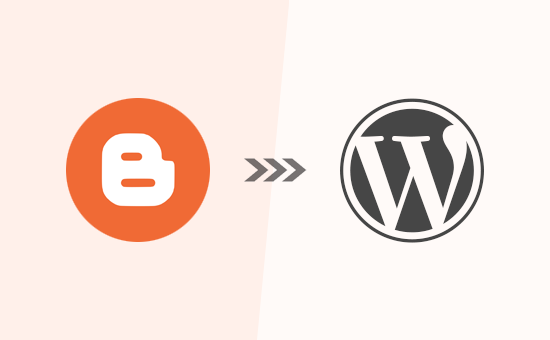
Why Move From Blogger to WordPress?
Blogger is a popular blogging platform created by Google. It allows anyone to create a free blog using their Google account.
However, many beginners soon realize that there are a lot of limitations on what they can do with their free Blogger blog.
WordPress, on the other hand, gives you complete ownership of your website. It also allows you to add the necessary features to grow your blog and monetize your content. Plus, you can perform all the SEO optimizations to rank higher. We have created a detailed side-by-side comparison of WordPress vs. Blogger.
It’s important to note that when we say WordPress, we are talking about self-hosted WordPress.org, which should NOT be confused with WordPress.com, which is a hosted solution that has its own limitations. For details, see our article on the difference between WordPress.com vs. WordPress.org.
WordPress.org is the popular “WordPress” platform that you have likely heard about because it powers 43% of all websites on the internet.
That being said, let’s take a look at how to properly move from Blogger to WordPress while preserving your Google search rankings and website traffic.
Here are the steps that we will use to transfer from Blogger to WordPress:
Ready? Let’s get started.
Video Tutorial
If you don’t want to watch the video tutorial, then you can continue reading the text version below.
Step 1: Sign Up for WordPress Hosting
To get started with WordPress, you will need a domain name and web hosting.
For a quick reminder, a domain name is your website’s address that people type to get to your blog, and web hosting is where your website files are stored. Both of these are a MUST-HAVE to create any type of blog or website.
With that said, we recommend using Bluehost. They are one of the largest hosting companies in the world, and they are an officially recommended WordPress hosting partner.
Because WPBeginner is the largest WordPress resource site, they have agreed to offer our readers a free domain name and a 60% discount on hosting. Basically, you can get started for just $1.99 per month.
If, for some reason, you would prefer to go with a Bluehost alternative, then we recommend using either SiteGround or Hostinger because both are excellent solutions.
Once you have signed up for the WordPress hosting plan and set up your domain name, you can go ahead to the WordPress installation step.
If you sign up with Bluehost using our link above, then they will install WordPress for you automatically.
If you used a different WordPress hosting provider, then you need to install WordPress by following our ultimate guide on how to install WordPress.
After you have installed WordPress, it is time to move your content from Blogger to WordPress.
Bonus Free Offer: Since a lot of you asked for this, we are now offering a free Blogger to WordPress migration service as part of our free WordPress blog setup service. This means one of our expert team members will do the entire migration for you (100% free). Yes, you can literally switch from Blogger to WordPress without any risk.
Note: Our free blogger migration service is for smaller blogs that have less than 1000 blog posts. We can offer a migration service for larger blogger sites, but that will be a paid service.
However, if you are someone who likes learning and doing things yourself, then you can follow our step-by-step tutorial below.
Step 1: Export Your Blogger Blog
The first thing you need to do is export your Blogger blog’s content.
You can do this by visiting the Blogger website and logging into your account dashboard.
After that, go to the Settings page. Scroll down to the ‘Manage Blog’ section, and click the ‘Back up Content’ button.
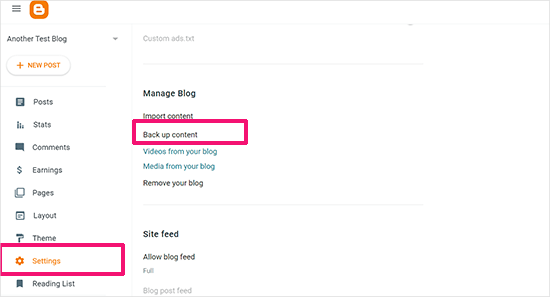
This will bring up a popup showing what exactly is included in the Blogger backup.
You need to click on the ‘Download’ button to continue.
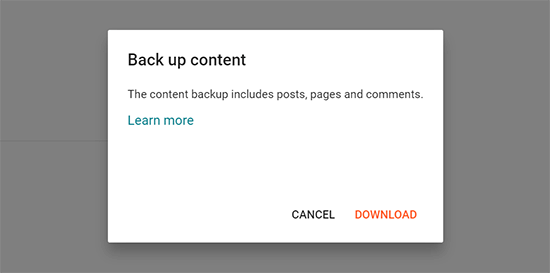
Your Blogger blog’s content will be downloaded to your computer in an XML file.
Once the download is complete, it is time to import your Blogger content into your WordPress site.
Step 2: Import Blogger to WordPress
To start importing your Blogger site into WordPress, log in to your WordPress admin area and visit Tools » Import.
On the Import page, go ahead and click on the ‘Install Now’ link below Blogger.
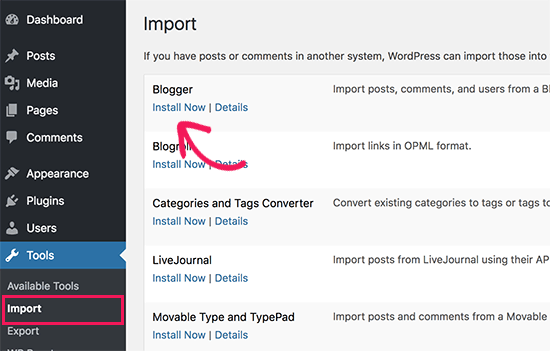
WordPress will now download and install the Blogger Importer plugin for you.
Once it has finished installing, you need to click on the ‘Run Importer’ link to continue.
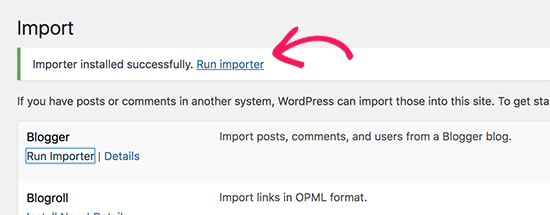
WordPress will ask you to upload the XML file on the Import Blogger screen. This is the file that you downloaded in Step 1.
Simply click the ‘Choose File’ button and upload the XML file you downloaded earlier.
Next, click on the ‘Upload file and import’ button to continue.
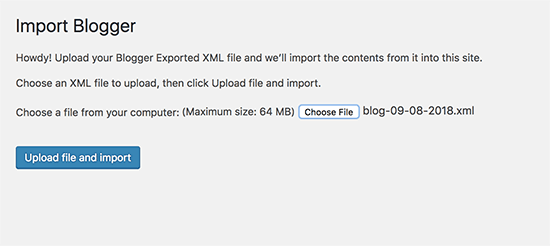
WordPress will now upload the import file. If your import file is too large, then you may see an error message.
In this case, you will need to increase your maximum file upload limit. If your file is small, then you won’t see any errors.
Next, you will be asked to assign posts to an author. If you have multiple authors on your Blogger blog, then you can create a new user account for each author. You can also assign these posts to existing authors on your WordPress website.
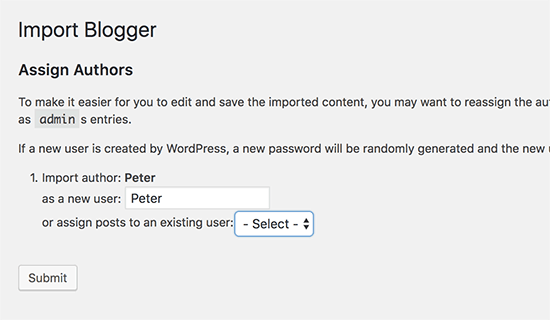
After making your selection, click on the ‘Submit’ button to continue.
WordPress will import all content from the Blogger export file to your WordPress site. You can view the content by visiting the Posts » All Posts page.
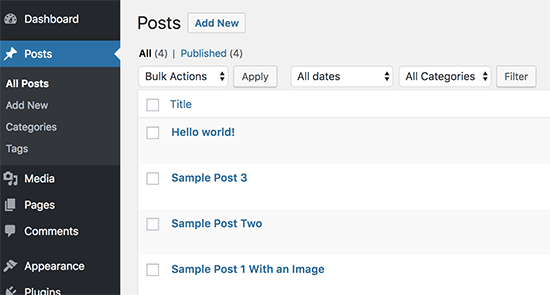
Step 3: Setting Up Permalinks
Permalinks is the term used for the URL structure of individual pages. WordPress comes with a feature that allows you to set up an SEO-friendly URL structure.
Since you are importing content from Blogger, you need your URL structure to be as close to your old Blogger site’s URL structure as possible.
To set permalinks, you need to go to Settings » Permalinks in your WordPress dashboard and choose the ‘Custom Structure’ option.
After that, you need to add the following text in the box next to the custom structure field:
/%year%/%monthnum%/%postname%.html

This permalink structure makes your blog post URLs similar to the URLs on your old Blogger blog.
However, sometimes your blog post URL, also known as a slug in WordPress, will not match the slugs used by Blogger.
To fix this, you will need to create and run a little code snippet.
We recommend adding this PHP code using the WPCode plugin. It is the safest way to add custom code to your WordPress website. For more details, please see our guide on how to copy and paste code snippets in WordPress.
add_action( 'init', 'wpb_update_slug' );
function wpb_update_slug() {
global $wpdb;
$result = $wpdb->get_results("SELECT post_id, meta_value FROM $wpdb->postmeta WHERE meta_key = 'blogger_permalink' ");
$wpdb->print_error();
foreach ($result as $row){
$slug = explode("/",$row->meta_value);
$slug = explode(".",$slug[3]);
$wpdb->query("UPDATE $wpdb->posts SET post_name ='$slug[0]' WHERE ID = '$row->post_id' ");
}
echo "DONE";
}
After saving the code, you just need to visit any page on your WordPress site to trigger this script.
Important: After the script has run, don’t forget to disable or delete it from your WPCode library because it only needs to run once.
Bonus Free Offer: Don’t want to deal with code? We have got you covered. Since many of you asked for this, we are now offering a free Blogger to WordPress migration service as part of our free WordPress blog setup service.
This means one of our expert team members will do the entire migration for you (100% free). Yes, you can literally switch from Blogger to WordPress without any risk.
Step 4: Set Up Redirects From Blogger to WordPress
The most important step in moving any website is to set up proper redirection so that you don’t lose any existing traffic or SEO rankings. You can see our ultimate WordPress SEO migration checklist for more details.
Note: If your Blogger blog has its own custom domain instead of blogspot.com, you may need to point your domain nameservers to your hosting provider. For instructions, please follow our tutorial on how to switch custom domain blogger blog to WordPress.
The crucial part of the redirection is to ensure that your users land on the same page on the new domain they were trying to access on the old site.
At the same time, you also need to ensure that search engines understand that your website is moved to this new location.
You need to install and activate the Blogger to WordPress Redirection plugin to do that. For more details, see our step-by-step guide on how to install a WordPress plugin.
Upon activation, you need to visit the Tools » Blogger to WordPress Redirection page and click on the ‘Start Configuration’ button.
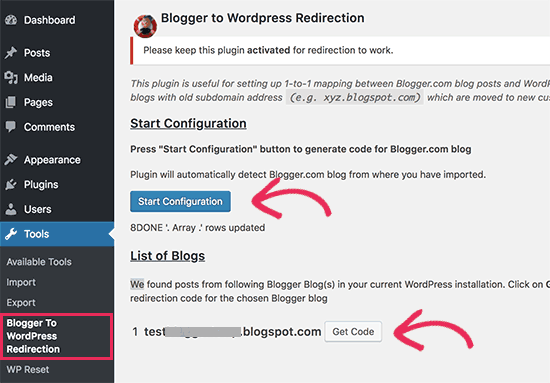
The plugin will now detect the URL of your Blogger blog and show you the option to get a redirection code. Go ahead and click on the ‘Get Code’ button next to your Blogger URL.
It will now generate a code snippet that you need to properly redirect users from your old Blogger blog to your new WordPress site.
Next, you need to log in to your Blogger dashboard and go to the ‘Themes’ page. Click on the dropdown arrow on the ‘Customize’ button next to your theme, and then select the ‘Edit HTML’ option.
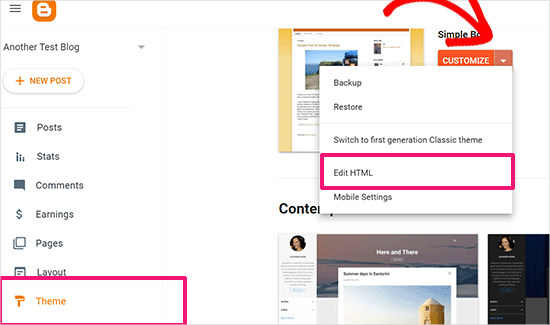
Blogger will now display the custom HTML code for your theme template. If you made any customizations to your Blogger theme, then you may want to copy the code and save it on your computer as a backup.
Otherwise, you can just go ahead and delete everything. After that, copy the code displayed by the plugin on your WordPress site and paste it into your Blogger theme editor.
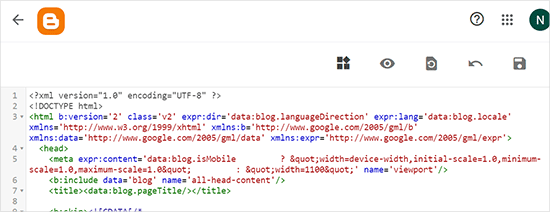
Don’t forget to click on the ‘Save theme’ button to store your changes.
Next, we need to set up redirects for mobile users.
You need to go back to the Themes page in your Blogger blog’s dashboard. This time you need to click on the gear button below the mobile preview of your blog.
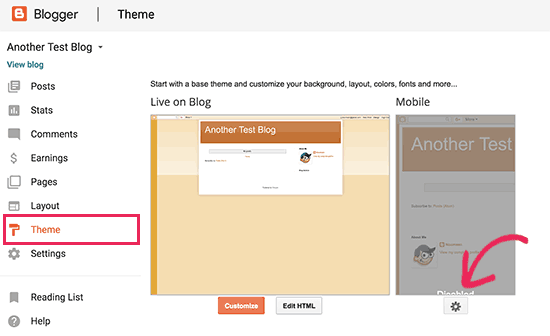
This will bring up a popup where you need to select the ‘No. Show desktop theme on mobile devices’ option.
Then, click on the ‘Save’ button.
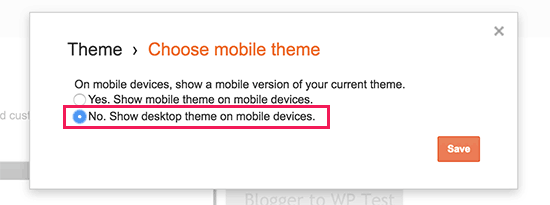
That’s all, your Blogger blog will now redirect all your blog visitors to your new WordPress blog.
Alternatively, you can also use All in One SEO (AIOSEO) to redirect posts and pages from Blogger to WordPress. The plugin offers a powerful redirection manager feature that lets you set up full site redirects to your new site.
Plus, you can enable 404 error tracking and catch any broken links that may occur when moving your site to WordPress. This will help improve the user experience, and you won’t lose keyword rankings.
Step 5: Moving Other Content From Blogger to WordPress
In this step, we will move the remaining content from the old blog on Blogger to your new WordPress blog. This may require some manual work, depending on the settings/content of your blog.
1. Moving Pages From Blogger to WordPress
WordPress’s Blogger importer tool only imports Blogger posts and ignores pages.
To move your pages into WordPress, you will have to edit each page in your Blogger blog, copy its contents, and then manually create a page in WordPress.
To learn more about pages, see our article on the difference between posts vs. pages in WordPress.
Now, you will come across another issue. The Blogger pages have URLs that look like this:
http://example.blogspot.com/p/about-us.html
Your WordPress page URL will look like this:
http://example.com/about-us
To fix this, you will need to use the All in One SEO (AIOSEO) plugin. For instructions, please see our beginner’s guide on creating redirects in WordPress.
2. Widgets
Like Blogger, some WordPress themes also utilize widgets to add content to your blog’s sidebar.
To add widgets, you need to visit the Appearance » Widgets page in your WordPress dashboard and simply drag/drop widgets into the sidebars. For detailed instructions, see our guide on how to add and use widgets in WordPress.
If you are looking for a specific widget you don’t see in WordPress by default, then you likely need a WordPress plugin. You can search WPBeginner’s best WordPress plugin category to find the functionality you want.
3. RSS Feeds
Search engines and users who subscribe to your blog posts via RSS feeds will still be able to find your blog. However, they will not get any new content.
To fix this, visit the Settings page under your Blogger account. Next, scroll down to the ‘Site feed’ section and click on ‘Post feed redirect URL’.
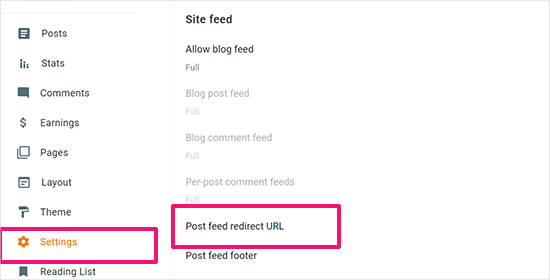
This will bring up a popup where you need to add the RSS feed URL of your WordPress website.
Your WordPress feed URL will look like this:
http://example.com/feed
Don’t forget to replace example.com with your own domain name.
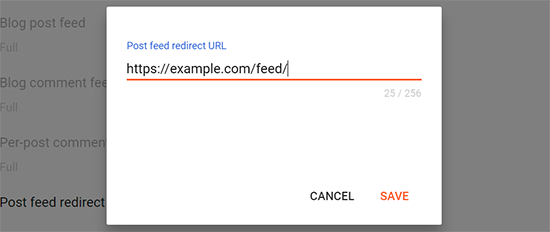
Click on the ‘Save’ button to add the URL and save your settings.
Step 6. Things to Do After Migrating From Blogger to WordPress
Now that you have successfully moved your Blogger blog to WordPress, let’s take a look at what else you can do to improve your blog.
We have created a checklist of the most important things you need to do after installing WordPress.
WordPress is quite easy to use. However, you’ll occasionally discover new things that you may need help with. This is where WPBeginner comes in.
WPBeginner is the largest free WordPress resource site in the world. We regularly publish tutorials and guides written specifically for bloggers and small businesses.
Here are some of the useful resources that you will find on WPBeginner (all of them are free):
- WPBeginner Blog – The central place for all our WordPress tutorials and guides.
- WPBeginner Dictionary – Our WordPress glossary is the best place to familiarize yourself with the WordPress lingo
- WPBeginner Videos – New WordPress users can start with these step-by-step videos to master WordPress.
- WPBeginner on YouTube – Need more video instructions? Subscribe to our YouTube channel with more than 291,000 subscribers and 50 Million+ views.
- WPBeginner Blueprint – Check out the plugins, tools, and services that we use on WPBeginner.
- WPBeginner Deals – Exclusive discounts on WordPress products and services for WPBeginner users.
We hope this article helped you switch from Blogger to WordPress without affecting your Google search rankings. You may also want to see our guide to which WordPress plan you should use or the most common WordPress myths debunked.
If you liked this article, then please subscribe to our YouTube Channel for WordPress video tutorials. You can also find us on Twitter and Facebook.





Syed Balkhi says
Hey WPBeginner readers,
Did you know you can win exciting prizes by commenting on WPBeginner?
Every month, our top blog commenters will win HUGE rewards, including premium WordPress plugin licenses and cash prizes.
You can get more details about the contest from here.
Start sharing your thoughts below to stand a chance to win!
Meghan says
Thank you for this great tutorial. If my blogger blog is already being redirected to my .com, are the steps the same when migrating to wordpress? Or do I need to go back to a web address before migrating? Thanks in advance!
Anandan K says
Hi,
The major problem I am facing right now after doing all the above mentioned is the urls are not being redirected to wordpress.
Eg. blogger urls have “.html” and wordpress do not, so I end up getting a 404 no result found page. Any help would be really appreciated.
WPBeginner Support says
The code you added in functions.php file should take care of that. Please repeat all the steps to make sure you haven’t missed anything.
Admin
Jason Booth says
This was a huge help in migrating our blog.
Unfortunately the redirects from Blogger don’t seem to work on mobile devices. Blogger appears to do a server side redirect to example.com/?m=1 before the template with the client side redirect loads.
Any thoughts on this? I can’t see anything in Blogger to change to force mobile devices to use the modified template with the client side redirect.
boethius says
@Jason Booth:
the ?m=1 problem is because you are still using a separate template for mobile for your blogspot. Disable it and then use the classic ones again, and it will work!
Giuseppe says
Hi! Thank you for this detailed guide.
I am not able to import embedded videos (most of them published on Youtube). Did I miss something?
Thank you
Nuhaa Bardien says
Hi! Thank you for this tutorial! I am really excited to be getting into WordPress and will definitely be using your tutorials to get me started!
Samantha says
I tried this and I think I have one of the codes wrong. My blogger site has a link that you have to click in order to be redirected to new site. Also when going to one of the old blogger posts directly, it still shows on blogger. No redirect at all. Please help!
Elizabeth Busey says
I’ve just followed all of your instructions to shift my blog from blogger to WordPress. I’ve been testing with google searches — using relevant key words but not my name. I am finding that for posts older than 2 months, it is marked as archived and the search finds the correct blog immediately. For newer posts (some which were done on Blogger and some directly on WordPress) the google search summary listing will have the correct blog, but the link goes to the blog roll where there are abbreviated versions of the blogs (in chronological order) that you can scroll through. But the searcher would have no idea which blog it refers to. I should add that the search is ignoring category labels which should be leading directly to a post and not the blog roll.
Whew! I’d appreciate any advice.
Brittny says
Thank you so much for this but I have one question about it, I was able to transfer my posts to WordPress but all my pictures are fuzzy and not the high quality like they were on blogger. Any reason why?
Thank you
Yas says
I have exactly the same problem !
!
Jana Gordon says
I have my permalinks set up correctly but my URL’s from Pinterest to my site are off.
Pinterest has this: http://example.com/2015/10/postname/.html
M site has this: http://example.com/2015/10/postname.html
How do I add that extra “/” before the .html in my WordPress permalink?
Vivian says
Im currently using 1and1 web hosting? How do i transfer to bluehost?
Im using blogger and would like to transfer to wordpress.org. The video is very helpful! I need to sit down and spend hours to do it. Wish me luck! =D
Thank you!
Vivian
WPBeginner Support says
Please take a look at our free blog setup service.
Admin
marlamarlas says
How will I transfer original artwork like logo and layout?
WPBeginner Support says
For logo you can save the image file and use it in your new WordPress site if your theme supports it. However, you may not be able to use the same layout in WordPress.
Admin
Adrienne says
Darn, I needed this last month. Oh well, I lost my ranking on this. But will look at this for the future.
Editorial Staff says
That sucks — you can still implement the redirect and get some of the lost traffic back.
Admin
Taylor says
After I have downloaded my blog from blogger, I don’t see the option on wordpress I don’t see “tools” on my side bar. I am using wordpress.com not .org.
Editorial Staff says
This guide and just about every other tutorial on this site is only for WordPress.org (self-hosted open source software). We do not offer support or tips for WordPress.com (closed platform).
Admin
Giampiero says
Thank you for this, I moved all my post “manually” from blogger to my wordpress site, this post would have been really helpful.
dameelare says
I use godaddy.com to host my site pls will it work on there also ?
WPBeginner Support says
Yes it would.
Admin
Rebecca Bryant says
Help i keep getting an error when I import. This is the error I get
Import Blogger
Sorry, there has been an error.
File is empty. Please upload something more substantial. This error could also be caused by uploads being disabled in your php.ini or by post_max_size being defined as smaller than upload_max_filesize in php.ini.
WPBeginner Support says
Please open the blogger import file you downloaded in a text editor to make sure that it is not empty. If it is, then try downloading the export file again.
If it is not empty, then please try increasing the upload_max_filesize limit in php
Admin
Hasi Aulia says
Hi Mate,
I Think you have to add some settings at .htaccess, I try this tutorial but I get problem, I get 406 page when get parameter that was sent by my old blogspot Redirect.
But I try to fix it with add this code at my .htaccess:
SecFilterEngine Off
SecFilterScanPOST Off
You should add this in the tutorial.
Thanks
WPBeginner Support says
Majority of users don’t need to do this. It basically by passes mod_security module in older versions of Apache. Please contact your web host for more information and ask them to upgrade Apache or have it properly configured to run web applications like WordPress.
Admin
Karan says
Hey! Amazing blogpost! Very helpful..I have exported my blog to wordpress..However, the permalink structure was of no use, as the blogspot blog used ‘dot html’ at the end of every slug..Hence, the old indexed links from google, take the visitor to a ‘Page Not Found’ message on my new wordpress blog..I followed all the instructions correctly..any help?
WPBeginner Support says
These instructions would work, the code we shared above can detect your blogger post and the WordPress code can match it to the same post in WordPress. The blogspot’s .html URLs are not an issue, and neither is country specific blogspot URLs.
Admin
Mario says
Thank you so much! It worked!
Budak kampung says
Hi,
Is blog transfer do able without cost? Thinking to do it with Bluehost but they charge USD99 for the process.
Jude says
I tried it for it didn’t work.
WPBeginner Support says
Can you please provide more details? It seems you have infiniteWP installed on that domain.
Admin
Connor Rae says
Wow, this is really helpful! I have been thinking about making the switch from blogger to WordPress for a while, but never thought it would be this straightforward. My blogger dashboard just picked up a habit that makes the page freeze, then give me a popup telling me to kill the page. Because of this, I can still make posts, but when I log in, I only get 2 clicks before the page dies, so editing previous posts is no longer possible. This has been going on for weeks, and bloggers support team had couldn’t explain what is going on, so I’m moving on to WordPress. Has anyone else had this problem with blogger where the page is slower than normal, then freezes and dies after 2 clicks/about 30 seconds, whichever happens first? If it’s a bug I can fix, or something I can wait out for an update to fix, I wouldn’t mind trying to just fix the blog that I have.
RAJENDER says
All my doubts about wp to blogger migration is cleared in a very good manner by reading this article. Thanks a lot # wpbeginners Team
Ana says
Hi, thanks for this tutorial. I have a doubt, I have a Blogger blog and want to move to WP, but not to a blog but to a website with a blog, so my posts permalinks would be mydomain.com/blog/2015/10/post-title.html, due to the “blog” slug it can’t be the same as the Blogger link, what can I do?
WPBeginner Support says
The above redirects and permalink settings should still work for you.
Admin
EIMIE says
I try switch my blog to new wordpress but not redirect.. how it?
WPBeginner Support says
Please see the redirection instructions above.
Admin
fabian says
What about moving from joomla to wp ?
WPBeginner Support says
Please see our tutorial on how to move your site from Joomla to WordPress.
Admin
Mary Grace says
Will it be okay if I just delete my Old blogspot blog after exporting since it’s just 1 month old? What I want to export is only my 40 articles.
WPBeginner Support says
It your blogspot blog was indexed by search engines then it is recommended that you use redirection. This helps search engines understand that your site has moved.
Admin
Connor Rickett says
This is wonderful! I had no idea this was actually possible, let alone relatively straightforward.
Derdus says
Hey thanks for the blog. I followed all the steps. However, all redirects goes to home of the new blog and not the correct post. What did I do wrong?
WPBeginner Support says
We have updated the article. Please follow the new instructions. Thanks.
Admin
Srinivas says
Hi , Thanks for indepth tutorial …
For some blogger posts , i have used custom permalinks ,will that give error when i migrate from blogger to wordpress ?
emeka obi says
Under the Page Attributes section i didnt see template or WPBeginner Blogger when creating new page that was after i have uploaded the text files to my wp theme using filezilla can some tell me where to find it?
Rickard says
Great guide for directing traffic from blogger to new site. The redirect works perfectly!
BUT… This does not return a 301 redirect status code!!
Tried several tools including:
It returns status code 200.
So… “without Losing Google Rankings”? – are you sure about that??
Dale Reardon says
I have read some warnings on other sites that Google has stopped interacting with the WP importer and you can’t currently import your Blogger blogs.
Is this true do you know? I see this article hasn’t been updated since last year hence why asking.
Dale.
Angie says
I ran into this issue, but instead used a plug in called Blogger Importer Extended and it worked even better with more features.
Shashwat Tiwari says
“You’re being redirected to this article because the application you’re using uses OAuth 1.0, and we only support the newer OAuth 2.0 at this time.” says google OAuth page which means blogger importer is not working anymore.
Randal says
Did you find any solution this version issue? I’m having the same problem.
Nevine says
Will this affect your adsense a/c and information in it?
Susan Smith says
My AdSense increased significantly after migrating to self hosted WordPress. I also set it to redirect all of the international domains from blogger as well.
Nenad says
I have custom domain on blogger… do I have to rename and buy new domain and after that migrate whole blog or stay at same domain? There are about 7.000 posts published at blogger blog.
Karen says
HELP!
So I followed these instructions EXACTLY and everything is redirecting beautifully.
EXCEPT that ALL of the links to my blog from Twitter, Facebook, Bloglovin, etc, ALL redirect to the same post from last September. I can’t figure out what the heck is going on, which makes it really hard to fix it. Any suggestions???
huislaw says
Thanks for the tutorial.
My pages are redirected correctly.
But when I try to use the function “Change of Address” in Google Webmaster Tools, it says:
“We couldn’t find any 301-redirect directives for your site. For more details check the Fetch as Google tool.”
Is there a way to make the Change of Address in Webmaster Tools?
Or is it important to inform Google about the change of address?
Thanks.
Chris says
I’m unable to import from blogger to WP. I didn’t give me a message; it didn’t do anything after I selected the IMPORT button. The posts don’t appear in the WP site. Help!
Nathan Nelson says
I had the same problem, this morning. Try using the plugin “Blogger Importer Extended”. That worked for me.
Shoks says
Same problem resolved with this plugin! Tnx
amy says
hi, has anyone figured out the permalink situation? My transfer is not working and I think it may have something to do with that… my theme uses a custom permalink.
Katie says
I’ve completed the instructions above and everything seemed to be right. But, when clicking on an old link on say twitter the link redirects and I get this error “Parse error: syntax error, unexpected T_NS_SEPARATOR in /home/sangla1/aspire2.com/wp-content/themes/salient/wp-blogger.php on line 15”
Not sure how to fix this. Any help would be great!
Karen says
Did you ever find a solution for this? I’m having a similar problem, except that instead of getting an error, my links redirect to an old post.
Arun says
Katie,
I was getting an error code similar to what you’ve posted and after umpteen trial and error, I found, it was caused by the wpb-blogger.php code. I copied it off the webpage and those line numbers in the code were intact.
When I copied the code by clicking on “View Source” on the top right corner of the code snippet, It started working.
Keshav Saini says
Hi,
I am using custom permalinks structure /%post_id%/%postname% in my wordpress blog so can’t use the permalink structure as specified in the post above. Doing the redirect causes 403 error for my blog. Do I have to change anything in the code to make it work with my current permalink structure?
Xander Lim says
This is what I need! It seems that blogspot has already given me full knowledge about blogging, now this will be the time to migrate it on wordpress platform. Thanks a lot for this guide, this is very helpful for me.
Peter Bates says
Where is the Post Feed Redirect url located on a hosted WordPress.org site? I see no feed subdirectory in my Wordpres.org site.
Raya Ezelle says
Yay! Thanks so much. All the old URL’s redirect perfectly
cesar says
Hi. doesn’t wordpress has a size limit for importing blogger’s xml file?
Jason says
I just wanted to thank you for this guide, it has been a great help when working with a client. Even though I had major problems with the Blogger Importer -plugin, rest of the process went smoothly when following this guide. Thanks again.
natachy says
i have completed redirecting my blogger to wordpress but the problem is redirecting my wordpress site so users are redirected to proper posts. I’m using a mac, i saved the code into a textile (without making any changes). when I try to upload it into theme directory, it keeps unpacking (not installing). please help
gaurav dutt says
I had a blogspot blog and a wordpress Veg Momos and the situation is that i don’t want to import my whole blog to the wordpress, but only few posts without re writing them, i would rather say i want migrate a particular category of posts. What should i do for that ?
sugar says
I am making a migration of the BBlogger blog to an existing self hosted WordPress domain. Thus Permalinks are already set to be http://www.domain.de/posts At Step #2 I should be adjusting my permalinks like you say, but my permalinks are already set. How do I solve this problem without killing the permalinks in the existing WordPress blog? Thanks for any help.